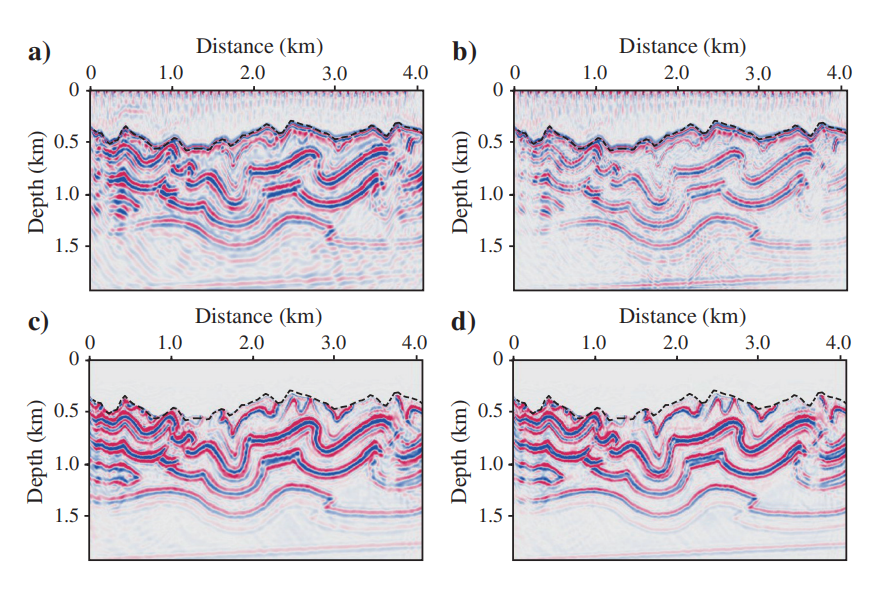The ocean bottom dual-sensor (OBD) observation system places water detectors (pressure sensors) and land detectors on the irregular seabed interface to receive acoustic pressure fields and elastic wavefields, respectively. These data are usually applied to effectively remove ghost waves and ringing interference in the seawater layer, rather than being jointly used for migration.Traditional imaging methods in the marine environment use a single elastic/viscoelastic wave equation to calculate wavefields. This approach is simple to implement because it only requires that the S-wave velocity in the fluid region be set to zero and is easily adapted to complex seafloor interfaces. However, the single wave equation method also has apparent drawbacks. It necessitates high P- and S-wave velocity ratios for stability and setting the S-wave velocity to zero leads to significant numerical dispersion.

Fig 1.The imaging results of the first and (c and d) the 30th iteration of the acoustic-viscoelastic coupled LSRTM with the curved grid.
An ocean bottom dual-sensor viscoacoustic and separated-viscoelastic coupled Q-compensated least-squares reverse time migration (OBD-VSV-QLSRTM) in curvilinear coordinates is proposed. In this method, to solve the Q-compensated elastic inverse problem, we jointly use the recorded acoustic pressure and elastic multicomponent seismic data from the OBD observation system. A new misfit function in the sense of least-squares inversion is constructed based on viscoacoustic
and separated viscoelastic wavefields. Acoustic and separated viscoelastic equations are used to describe the acoustic wave field in the acoustic medium and the Q-compensated P and S wavefields in the underlying viscoelastic medium, respectively. On the acoustic-viscoelastic interface, we implement a stable governing equation to ensure continuous and steady transmission of Q-compensated stresses in the subseabed and pressure in the seawater. To address the irregular seabed problem, we mesh the acoustic-viscoelastic models onto curvilinear grids and apply coordinate transformations to map the models and equations to a new curvilinear coordinate system. We derive viscoacoustic and separated-viscoelastic coupled adjoint and demigration operators in the curvilinear coordinates, enabling linear acoustic-viscoelastic modeling and stable receiver-side back-propagated wavefield continuation. Numerical examples conducted on two typical acoustic-viscoelastic models demonstrate that our proposed OBD-VSV-QLSRTM in curvilinear coordinates can produce highly accurate P- and S-wave images efficiently.
CITATION: Jin-LiLi, Ying-Ming Qu*, Yi-FanLi,Chong-PengHuang, Zhen-Chun Li, 2024, Ocean bottom dual-sensor Q-compensated elastic least-squaresreverse time migration based on acoustic and separated-viscoelastic coupling equations.Geophysics, 89(3), S155–S173, doi: https://doi.org/10.1190/geo2023-0433.1

